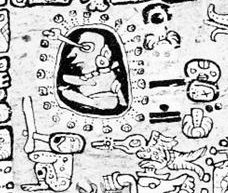The sky is coloured red both at dawn and at dusk. Both Aldebaran and Antares are red stars.
Red is the colour of life, expressed e.g. by blood and by the heart. In the bi-cycle of the year the signs of life are most evident at the equinoxes, when there are swift changes. The sign of death is at the solstices, when nothing moves in mother nature. In this Egyptian picture the female birds form a great diamond with their outspread wings, and we can imagine the straight path of the single Sun (as a scarab 'tree' with a jawning monster head at bottom) rising up between his pair of wives:
These great wings form the pairs of the oppositely oriented sides in a rhomb (diamond). Regarded as a picture of the yearly cycle (there are 19 stars in the roof) we can deduce the equinoxes must be at the 'Things' of the goddesses. ... A 3rd hanau is depicted in May 25 (5-25), the day when the main rongorongo calendar cycle returns (hoki) to its 'heart' of origin. This is where Ain (Bull's Eye) was rising heliacally and this is where the Heart (σ) of the Scorpion was close to the full moon. This is also where the G text is beginning:
A new King (ariki) arrives in May 26 and a kava ceremony is necessary for his installation (at the end of Sheratan and 150 days from the beginning of the Gregorian year) ... ... After he had made these male images Tu'u ko ihu fell asleep and dreamed of two women. Their names were Pa'apa ahiro and Pa'apa akirangi. In his dream he saw that they were hiding their Things with their hands, they were covering them with their fingers; therefore as soon as it was daylight he got up and carved two flat images exactly like those women.
The peculiarly bent form of the women images are expressing the same form as the Egyptian goddesses above. The men wooden images were contarywise standing tall and straight. My glyph type mea ke - 'another (red) thing' - could represent the straight 'tree' which stops at winter solstice:
When the 'head' of the 'bird' is on fire he is at a 'bay', a cardinal ('heart') point in time.
The head of the bird which is standing still in Ca5-15 could be the sun. In principle it is the same type of sign as that for a star (because the sun is a star), but it is markedly greater and it has 5 'flames'. None at bottom where his manu rere is. In the Egyptian star roof above there 5 * 19 = 95 'flames', and 4 * 95 + 19 = 399 = 21 * 19.. Sun is perhaps also depicted in the center of the glyph where Bright Fire (λ Cancri) is rising heliacally:
A 'penis' is drawn at bottom of the honu at Heap of Fuel (μ Cancri) and hakapekaga 3 days later has a double meaning, not only alluding to the 'place of crossing over' but basically rather referring to the stimulating effects of the head of the Sun King - making not merely thousands but hundreds of thousands (peka) be born. The 'tentacles' above and below could possibly represent the regions of 'sky' respectively of 'water'. Sun is number 1, standing straight and tall. The Mayan sign for 1 is a (sun) dot:
Zero depicts the closed 'bivalve' (with unknown contents). Sun has 4 quarters ('sons') and only from number 5 is there a flat horizontal line. I suggest the black dots represent a time of origin, like when a new month is beginning with Moon not visible. 4 * 20 = 80. When Sun has become visible (is present), then number 1 can be depicted as a circle, this we can read: ... The Maya word cab means earth, world, tierra, the place below, opposed to caan, the sky. The overwhelming evidence on the glyph and its associations in the pictures and texts is for this same meaning, Earth. A most interesting glyph in this connection is one found in Maudslay's Tikal, plate 74, glyph 13, our form 17.33  The text on the stela shows that this glyph indicates the passage of one day, from 6 Eb, 0 Pop to 7 Eb, 1 Pop; the sun or kin, preceded by the numeral 1, is seen entering between the caban-sign and what we shall later come to identify as the sky-glyph ... The kin (sun sign) is drawn as a circle with 4 corners created by a central cross and there is a narrow crescent at right. The 'crescent canoe with sail' from time zero is standing vertically like a tree when Sun has arrived, when he has pushed sky and earth apart, allowing air and light in. At right in the glyph there is a vertical arrangement with a great star sign (once again probably representing Sun) in the center. There are 2 'shells' visible - the 'bivalve' is open. It is no longer time zero but time 1. Metoro's hakapekaga mai, with mai translated as 'from', could mean Sun no longer is standing still surrounded by 'flames', that from here (day 1) counting can once again proceed. Above and below in the vertical arrangement at right (in 17.33) there is a pair of canoe-like ovals which could refer to Moon. In the night the Mayan astronomer is evidently grasping the stars helped by Moon as time-giver:
The astronomer is not sitting in a dark cubicle, he is surronded by the light from the stars and his sitting posture is different. The figure at left below, on the other hand, is sitting in 'the posture of moe' (the way the Rain God is sitting in his 5th station) - and we recognize the caban (earth) head. Above is sky (caan) and below is earth (caban). | |||||||||||||||||||||||||||||||||||||||||||||||||||||||||||||||||||||||||||||||||||||














